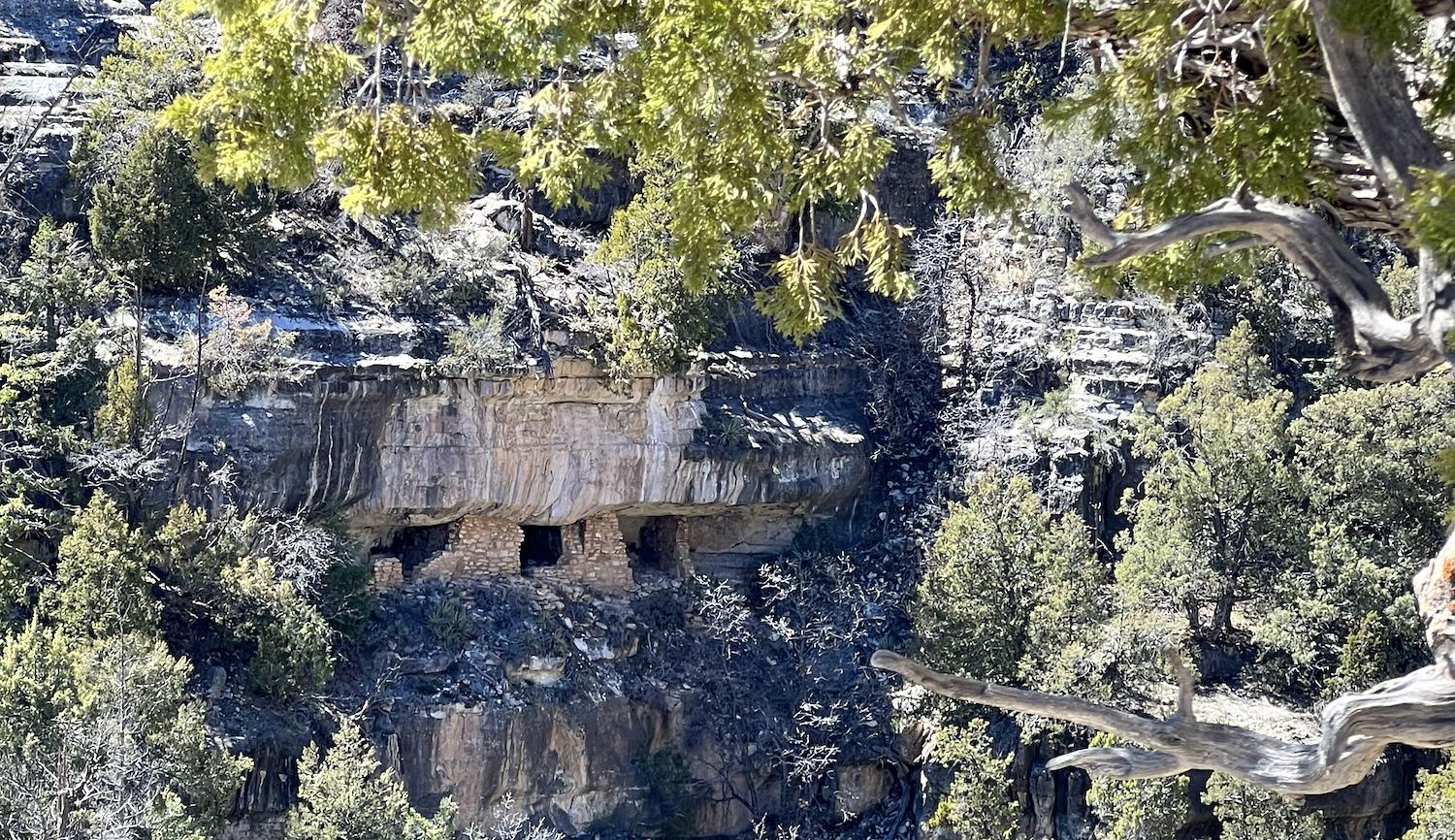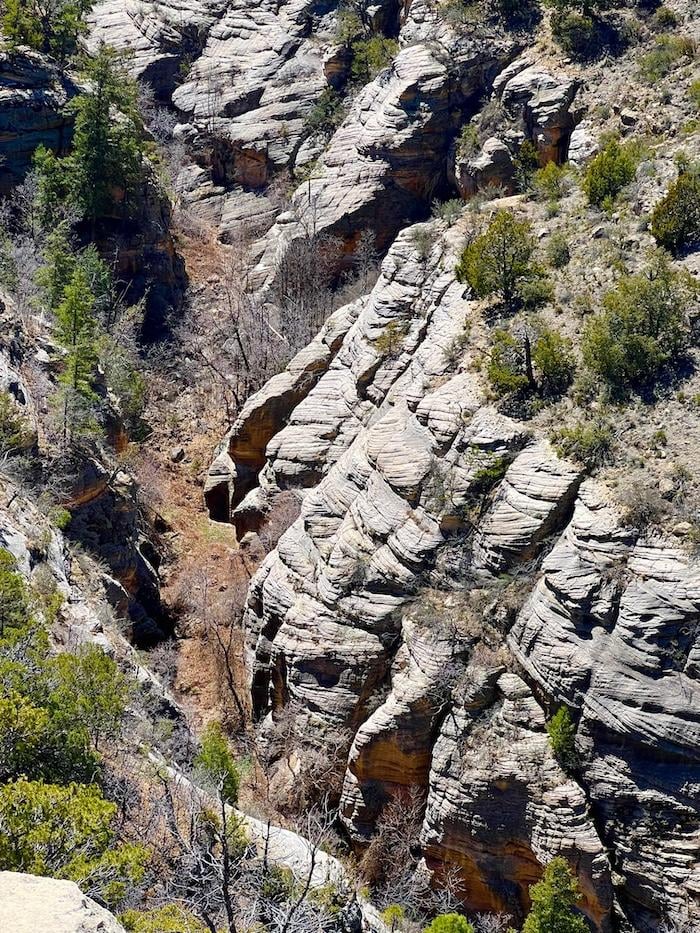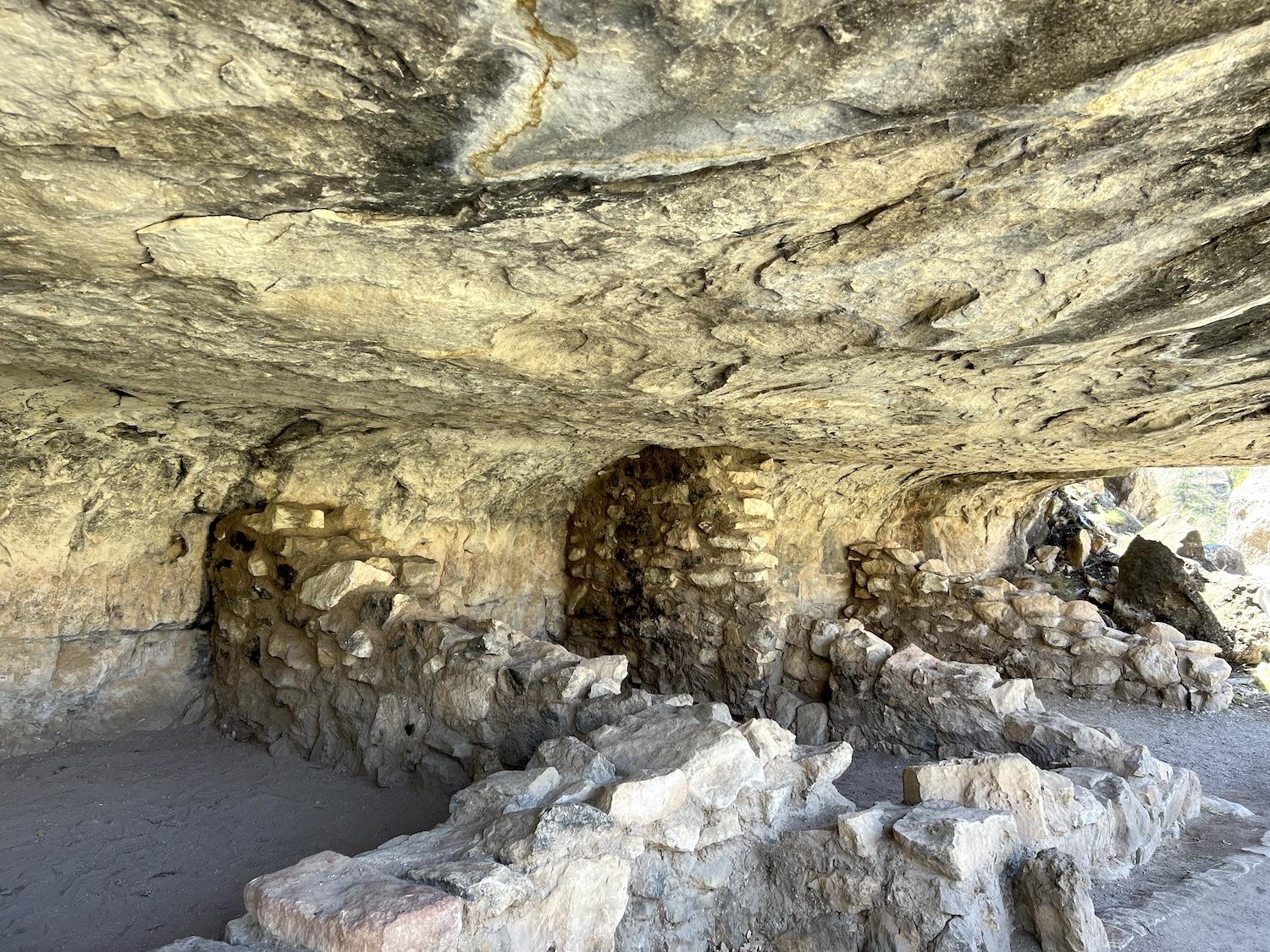
Hundreds of cliff dwellings once lined the canyon walls that rise above Walnut Creek/Barbara 'Bo' Jensen
The Sinagua —The People Without Water
By Barbara "Bo" Jensen
WALNUT CANYON NATIONAL MONUMENT, Arizona —The highway begins to curve, slowly meandering up into Ponderosa pine-forested mountains as you approach Flagstaff, Arizona. All the roads do, from any direction; that’s how you know you’re almost there. People have been wandering through the volcanic hills and hidden canyons around the San Francisco Peaks for thousands of years. Ancestors of the Hopi, Zuni, Navajo, Yavapai, Havasupai, Hualapai, Western Apache, and Southern Paiute peoples all passed this way, as their descendants still do today.
Archaeologists have identified artifacts such as projectile points from this area dating back to 13,000 years ago, attesting to ongoing human access to bountiful resources. Ancient people repeatedly left their mark here, through rock art and constructed trails, and eventually, stone masonry alcove houses — cliff dwellings — like those built into the eroded limestone cliffs of Walnut Canyon beginning around 1100 CE.
According to Northern Arizona University’s American Southwest Virtual Museum, “Walnut Canyon National Monument protects more than 500 archaeological sites along … ten miles of Walnut Creek.” That’s a lot of concentrated human presence. The online museum site preserves images of inaccessible pictographs and petroglyphs, allowing viewers to examine these fascinating but fragile symbols, messages left in stone for us to try to decipher today. Such clustered evidence speaks to continued local abundance. So why did the people who built these sturdy stone houses in Walnut Canyon quickly leave their homes behind?

A dry creekbed today marks the path of Walnut Creek/Barbara 'Bo' Jensen
What Forced Them Out?
They have been called the Sinagua — The People Without Water. Spanish explorers referred to this region as Sierra Sin Agua, “mountains without water,” and archaeologists adopted the name. Here in the high desert of the Colorado Plateau, it’s easy to assume the Sinagua people simply ran out of water and left, moving on as their most vital resource dried up. However, as a National Park Service ranger explained, scientists now think there is a bigger, more complicated story of significant regional climate change that once impacted the area in and around the national monument.
Looking down from the monument’s flat Rim Trail, it is clear that Walnut Creek no longer flows 400 feet below, down at the bottom of the quarter-mile-wide canyon it carved over the course of six million years. But Walnut Creek’s end came relatively recently, in 1904, when the creek was dammed to create Lake Mary, diverted for use by the city of Flagstaff. Back in the 1100s, the creek likely was still running. The issue that drove out the Sinagua was bigger than water access.
Rimtop pueblo and pit-house ruins remind visitors that the Sinagua once lived and grew crops on the tableland above the canyon, as well. Their population grew and flourished for about 150 years while they lived here. Maybe they hauled water in heavy redware ollas on their heads or on their backs all the way from the creek to their fields above. Or maybe enough rain once fell in these mountains to barely sustain the corn, squash, and beans they grew together, the squash leaves shading the thirsty soil.
According to the National Park Service staff here, evidence now suggests climate change tipped that precarious balance: multiple decade-long periods of considerably drier, colder weather, one stretch after another, would have damaged or destroyed their crops and probably decreased the creek’s flow as well. This climate shift also may have resulted in unforeseen survival issues such as firewood shortages as the large Sinagua population burned more and more trees to heat their homes in the now bitter cold.
You don’t usually think of cold when you think of Arizona. The elevation at the top of Walnut Canyon, though, is nearly 7,000 feet. Think mountains instead. This is high country, with changeable weather, a place where snow often lingers into spring, even in today’s warming climate.
Hiking 185 feet down from the rim on Island Trail, the mile-long elevated loop around a massive, rocky hill in the middle of the narrow canyon gives visitors a bird’s-eye view of 25 alcove rooms, all carefully walled with stone into the surrounding cliffs. This steep trail, including 240 steps and sheer drop-offs beyond the pipe handrails, was created by the Civilian Conservation Corps in the late 1930s.
In winter, the trails the Sinagua people would have followed up and down this canyon, with its distinctly sunny and shady sides, would have been dangerously inconsistent, first snow-packed then icy, slick and muddy where melted, suddenly windy around any turn. No handrails. Imagine hauling water, or carrying a child, or guiding an elder along that path. Now imagine that everyone is cold, sick, and in danger of going hungry.
Interpretive information at the monument notes, “Despite all it had to offer, in time Walnut Canyon became a difficult place for farmers to live. Drier, colder conditions meant crop failures. More people and diminished resources meant nutritional stress, disease, and conflict.”
By 1250 CE, nearly all the Sinagua people had departed, many, it is believed, to the nearby Hopi mesas. The Hopi call these ancestors the Hisatsinom, Those Who Lived Long Ago. To the Hualapai, they were Gud Ganu:w; Navajo, Nizhizazi; Yavapai, Juka; Zuni, Inodekwe.
Were They Climate Refuges?
The question remains: were the Sinagua climate refuges? That depends on your perspective. Hopi tradition embraces migration as part of their religious beliefs, a spiritual practice. According to an anthropological paper included in Sunset Crater Archaeology (2005) cited by the National Park Service and titled, “Nuvatukya’ovi, Palatsmo niqw Wupatki: Hopi History, Culture, and Landscape”:
“Many reasons are given for clan migration in Hopi traditional history, including drought, famine, cold weather, …disease, warfare, …and natural disasters. However, from a Hopi perspective, the primary reason for migration is the fulfillment of a spiritual covenant…. The religious intentionality of Hopi migration receives scant attention in most archeological reconstructions of the past.”
From their perspective, this site may have been just a temporary stop along the way for the Sinagua, people seemingly wandering into and out of these mountains. Still, that transience doesn’t mean their hardships were easy or their choices casual. They had reasons for leaving.
Looking into the empty rooms of their alcove houses, and then out over the wind-scoured rocks of Walnut Canyon, it is interesting to contemplate the larger Hopi ideal: unity, a heart-felt intentionality to their migration, and a spiritual or religious understanding of — and response to — that act. Some version of this ancient perspective may become very relevant, very soon, to all of us, as together we face both the likely and the unexpected outcomes of ongoing climate change across a much wider world.

Look carefully into the cliff dwellings and in places you can see the blackened soot their fires left on their ceilings/Barbara 'Bo' Jensen

Add comment